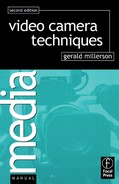While you are shooting and concentrating on the action, the available depth of field can vary without your realizing it. So be prepared! Remember, when you refocus as the distance of the subject or camera alters, or you operate the zoom, or you change the f-stop (e.g. opening it up as you move into a building), the depth of field will alter! You will notice this most on closer shots.
As a rough guide, about one-third of the focused depth extends in front of the focused distance (focused plane) and two-thirds beyond it. The overall depth available at a given stop is greater for smaller CCD formats.
Most lenses perform best when they are only partially stopped down (e.g. f/5.6 to f/8). Although the obvious answer to restricted depth of field is to stop the lens right down (e.g. to f/16), this is usually impracticable under typical light levels, and can lead to inferior picture quality.
You can light some subjects (e.g. machinery, statues or coins), to very high intensities to ensure maximum depth of field. But others such as plants, delicate materials, and people, may be harmed under such dazzlingly hot conditions. Ventilation too can become a problem.
If you open up a lens to maximum aperture in order to reduce focused depth or when shooting under low-light conditions, picture definition and tonal clarity may deteriorate as optical defects become obvious (flare, aberrations).
ND filters are obtainable in a series of densities, to aid exposure control. But lower quality filters are liable to degrade clarity to some extent.
Zooming in, depth of field decreases. Zooming out, the reverse happens. When someone walks to or from the camera, the zoom’s focal length will influence how much you have to readjust the focus control to compensate for their changing distance and how critical focusing becomes.
You soon become aware of how shallow the depth of field really can be when working with a long focal length lens (zoomed in; telephoto; narrow angle). If you are moving around and then suddenly zoom in, focusing can be quite hazardous!
Focusing is easiest when using a short focal length lens (zoomed out; wide angle). Thanks to the greater depth of field, focusing may hardly need adjustment. But of course, everything now looks so far away! And as we shall see, moving closer can produce noticeable distortions.
When depth of field changes
A. Lens aperture. As the lens is stopped down, depth of field increases.
B. Lens angle. As the lens angle increases (shorter focal length), depth of field increases.
C. Camera distance. The further away the camera focuses, the greater the depth of field.

